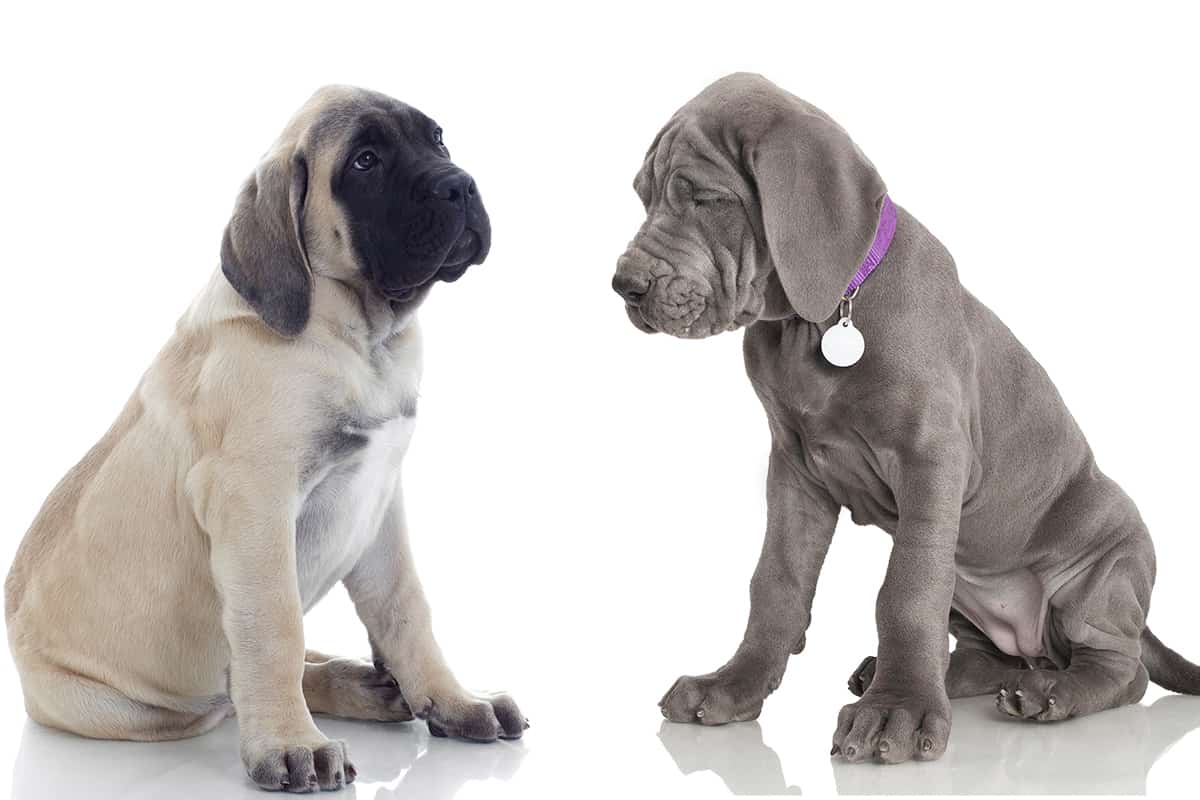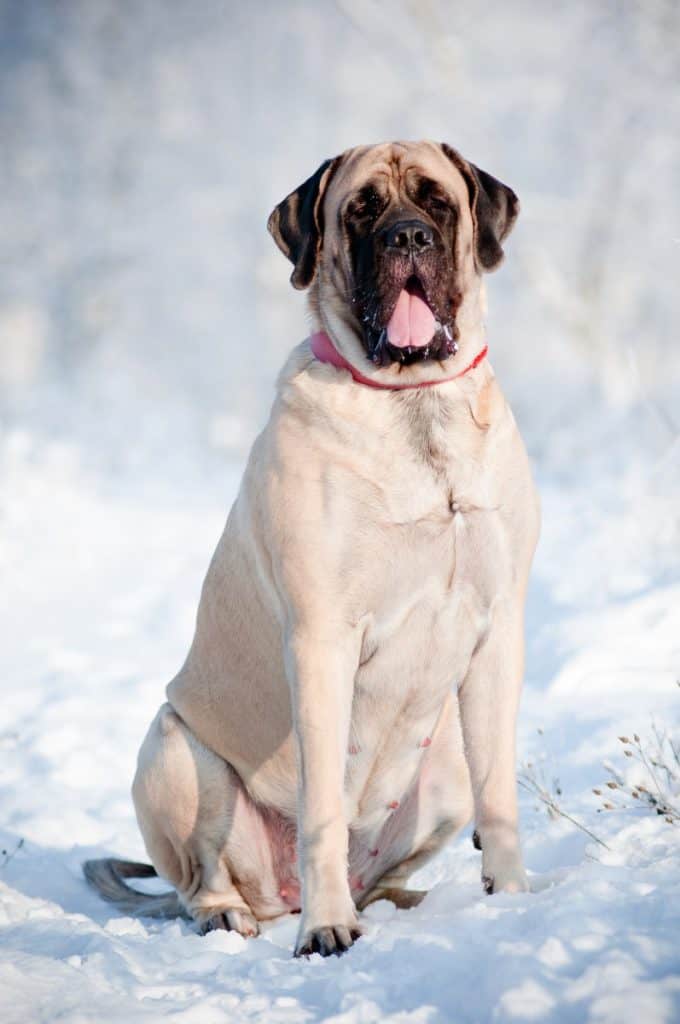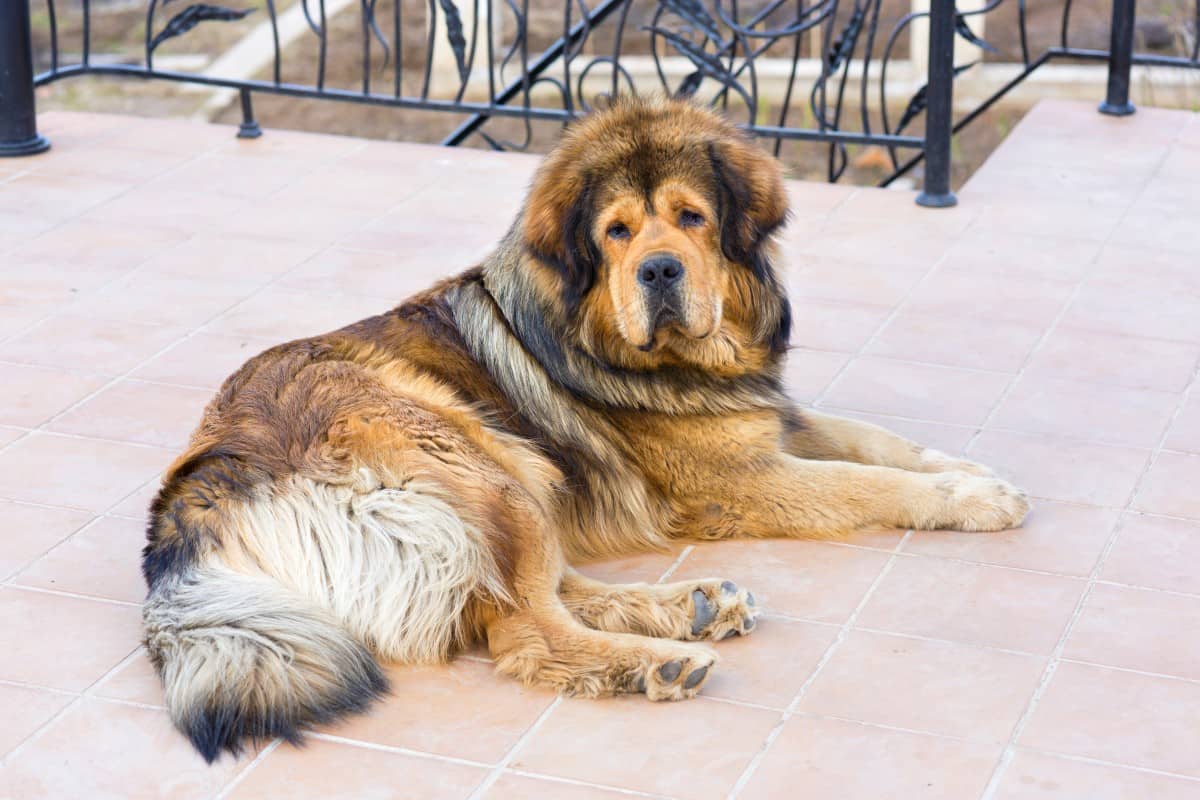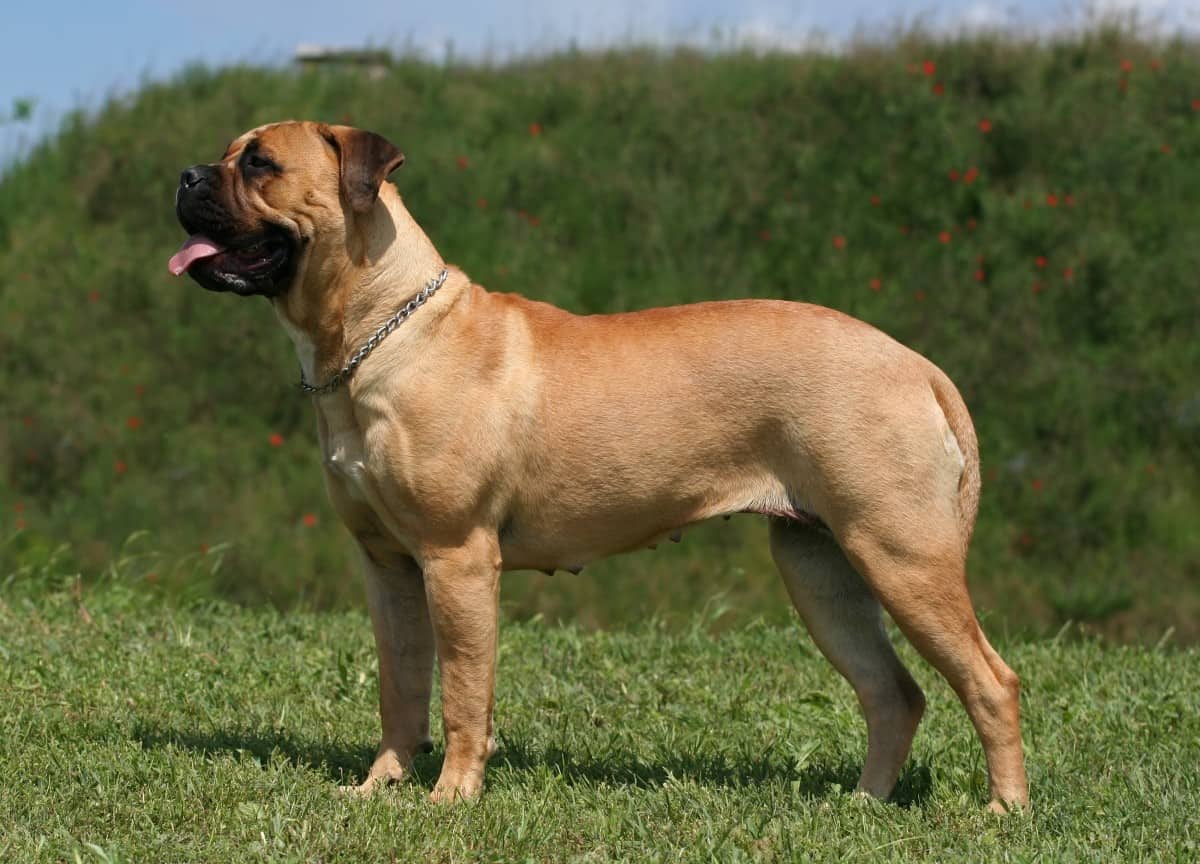
Due to their massive size and muscularity, it’s not unreasonable to wonder if Great Danes are a mastiff breed. Both are majestic and quite literally featured in legends, making it an even more legitimate question!
So, is a Great Dane a Mastiff?
Technically, Great Danes are not part of the Mastiff family. However, Great Danes are believed to be descendants of Mastiffs and have been cultivated as their own distinct breed for at least the last 400 years. Therefore, explaining many of the similarities seen between them.
While Great Danes aren’t technically a Mastiff, there are still a lot of similarities between them. Let’s take a look at some of the similarities and differences between Great Danes and Mastiffs!
Similarities and differences between Great Danes and Mastiffs
Before jumping right in, it’s worth pointing out that there are actually several breeds that make up the mastiff family.
The four breeds that make up the Mastiff family include the:
- English Mastiff
- Bullmastiff
- Neapolitan Mastiff
- Tibetan Mastiff
In case these breeds don’t all ring a bell, I’ve included an image of each below for reference. Naturally, these will also be helpful as we walk through the similarities and differences between them!





And for easy reference, here’s a photo of our other gentle giant – the Great Dane 😉
Comparison #1 – Size
Looking at these dogs, there’s one extremely obvious similarity between them – their LARGE size!
Because pictures sometimes make it hard to get a true understanding of their size, let’s take a look at the expected sizes for each of these breeds. These numbers will include the average expected height and weight across both males and females for each.
| Breed | Height [inches] | Weight [pounds] |
| Great Dane | 28 – 32 | 110 – 175 |
| English Mastiff | 27.5 – 30 | 120 – 230 |
| Bullmastiff | 24 – 27 | 100 – 130 |
| Neapolitan Mastiff | 24 – 31 | 110 – 150 |
| Tibetan Mastiff | 24 – 26 | 70 – 150 |
After looking at the raw numbers, it’s pretty clear that these are all BIG dogs! Particularly when looking at the height and weight of Great Danes and Mastiffs, these dogs are quite literally larger than life.
Because many people are overwhelmed by their sheer size, it can be easy to overlook the differences between them.
While all of them are big, they are big in slightly different ways.
Most notably, Mastiffs have a shorter and heavier build compared to Great Danes. If you’ve ever pet one, you can attest to their dense frames!
While a healthy Great Danes certainly carry their own fair share of lean muscle, it’s not to the same degree as a mastiff. Also as seen in the chart, Great Danes are taller by comparison than Mastiffs.
In short, making Great Danes the taller but leaner version of a Mastiff.
Comparison #2 – Coat
With the exception of the Tibetan Mastiff, Great Danes and the remaining Mastiff family have very similar coats. Comprised of short compact coats, these dogs have minimal grooming requirements when it comes to their coats!
However, when it comes to the coloring of their coats, there are a few differences.
Below is a breakdown of the officially recognized colors for each according to their breed standards.
- Mastiff: fawn, apricot, or brindle stripes.
- Bullmastiff: fawn, red, or brindle.
- Neapolitan Mastiff: blue, black, mahogany, and tawny.
- Tibetan Mastiff: black, black and tan, blue gray, blue gray and tan, brown, brown and tan, red gold, and red gold sable.
- Great Dane: black, blue, fawn, brindle, harlequin, mantle, and merle.
While there are overlaps between them, it’s interesting to note that note a single “official” color exists that overlaps amongst all five of these breeds.
Lastly, it’s worth revisiting the fact that Tibetan Mastiffs have a vastly different coat from Great Danes. TMs have a thick double coat, with a heavy, wooly undercoat and coarse guard hair.
Often referred to as the guardians of the Himalayas, their sturdy coats must have come in handy in these wintry conditions. By comparison, our Great Danes are far from well-suited to any extended amount of time in the cold!
Comparison #3 – Head Shape
In addition to their large physical stature, it’s the heads of Great Danes and Mastiffs that I find particularly striking. They have such strong distinct shapes, that truly separate them from other breeds.
Just looking at these dogs, you can’t help but think of them as strong and noble creatures!
For a more exacting description of their heads, let’s take a look at what their respective breed standards have to say.
The head shall be rectangular, long, distinguished, expressive, finely chiseled, especially below the eyes. Seen from the side, the Dane’s forehead must be sharply set off from the bridge of the nose. The plane of the skull and the plane of the muzzle must be straight and parallel to one another. The skull plane under and to the inner point of the eye must slope without any bony protuberance in a smooth line to a full square jaw with a deep muzzle.
Great Dane Breed Standard
Now, let’s compare that to the Mastiff breed standard!
In general outline giving a massive appearance when viewed from any angle. Breadth greatly desired.
Mastiff Breed Standard
Similar to their bodies, it’s interesting to note the specific mention of “breadth” in the Mastiff breed standard. While large size is still important, the additional width is found to be desirable.
By comparison, the Great Dane breed standard calls out a “rectangular long” head. As would be reasonable, their head shape more closely aligns with their long bodies to retain symmetry.
Comparison #4 – Personality
Their size isn’t the only close correlation between these giant dogs! They also share very similar personality traits.
Despite their size, Great Danes are known for their sweet, gentle, and loving personalities. They love to spend time with their family and loved ones, and will often follow their family around the house just to be close to them.
Similarly, Mastiffs are known to be patient and loving companions. Like Great Danes, their affection for their family can lead them to be excellent guardians when called upon.
While every dog’s personality is different, Mastiffs tend to be more protective of their family and less trusting of strangers. Of course, a properly socialized Great Dane or Mastiff can easily be taught to overcome these traits if they do present themselves.
As you can see, these big dogs are really just big softies! Their affection for their families matches their oversized selves 🙂
Comparison #5 – Energy Level
Compared to their smaller canine friends, big dogs tend to have lower energy levels. This is no different when it comes to Great Danes or any of the breeds in the Mastiff family.
While each has a relatively low to moderate energy level, here’s a breakdown of what you can expect on average. These are numbered from the least to the most energy per breed.
Lowest to Highest Energy Ranking
- English Mastiff
- Neapolitan Mastiff
- Tibetan Mastiff
- Great Dane
- Bullmastiff
What I found most interesting here is that by comparison, Great Danes were on the higher energy end of the group! This is especially surprising considering that they’re the second largest of the breeds.
None of these breeds need excessive amounts of exercise to handle these energy levels, but most will still enjoy and benefit from regular walking.
Once they’ve reached an appropriate age, Great Danes have even been known to participate in more athletic events such as agility. If this sounds fun, make sure to take a look at our dedicated article on agility for Great Danes.
One interesting callout is that Tibetan Mastiffs enjoy more work-related tasks compared to structured play for burning off energy. This must stem from their ancestral roots, but things like patrolling a yard are perfect for satisfying their needs.
While these energy levels figures were retrieved from AKC.org data, keep in mind that they are just general numbers and each dog’s energy levels will vary.
Comparison #6 – Life Expectancy
While never a fun topic to talk about, another area of overlap between the Great Danes and the Mastiff family is their shorter life expectancy.
While it’s generally expected that larger dogs have shorter lifespans, that certainly doesn’t take the sting out of losing a loved one.
The numbers below showcase the general life expectancy for Great Danes, Mastiffs, Bullmastiffs, Neopolitan Mastiffs, and Tibetan Mastiffs.
| Breed | Life Expectancy |
| Great Dane | 7 – 10 |
| English Mastiff | 6 – 10 |
| Bullmastiff | 7 – 9 |
| Neapolitan Mastiff | 7 – 9 |
| Tibetan Mastiff | 10 – 12 |
Each breed falls into a roughly similar range, with a group average life expectancy of 7 – 10 years. Keep in mind that these numbers are just averages. There will certainly be dogs that live both shorter and longer than these averages.
Feeding your dog high-quality food, keeping up with vaccines and vet visits, as well as general preventative care are just a few of the ways to help ensure your giant canine spends more time with you.
While I’m not an expert on the Mastiff breed, I did find it interesting that Tibetan Mastiffs had a noticeably longer life expectancy than the others!
My best guess is that being the smallest of the group with an average weight of 70-150 pounds plays a factor in it.
What is the biggest Mastiff breed?
As previously noted, there are four breeds that comprise the Mastiff family. These include the English Mastiff, Bullmastiff, Neapolitan Mastiff, and Tibetan Mastiff.
Out of the four breeds in the Mastiff family, the largest is the English Mastiff. On average, they are both taller and heavier than the other breeds in the family. In particular, their large weight is what truly separates them from the rest.
Naturally, there will always be outliers, so these are just general considerations.
The chart below references the average height and weight of each breed in the Mastiff family.
| Breed | Height [inches] | Weight [pounds] |
| English Mastiff | 27.5 – 30 | 120 – 230 |
| Bullmastiff | 24 – 27 | 100 – 130 |
| Neapolitan Mastiff | 24 – 31 | 110 – 150 |
| Tibetan Mastiff | 24 – 26 | 70 – 150 |
If you’re still not positive on how to identify a Great Dane, then make sure to look at this article that covers their appearance from head to tail!

Hi Zach,
I have been enjoying your weekly articles. Keep them coming.
I used to show my Great Dane along with a breeder that showed bullmastiffs for conformance. We both got our dogs their Championships. I think your images/titles of a Bullmastiff and a English Mastiff above need to be switched… It looks like what you name as an English Mastiff is actually a Bullmastiff and vice versa.
Just a thought.
Rod
Thanks for catching that, Rod! Should be fixed now – Zach
Hi Zach,
Your articles are very helpful. Iam a first time Dane owner. Not my first time with giant breeds. Now that I am older their temperament and energy levels are more fitted to my activity level. I got Enzo when he was 4months, he now is 7months and his energy level is way higher than my Newfie or Saint Bernard. Also harder to train due to stubbornness. I think some of the problem is he was older than 8weeks. I start training as soon as I get them home. So at 4months he acquired traits I am hoping to resolve through positive training. Iam old school never used a prong collar or a Ecollar for any of my dogs, now that seems the norm for trainers. At what age can I expect his energy level to decrease and loose the attitude? These are not qualities of most giant breeds. I did my research and energy level and difficulty training was not a issue for this breed. It’s not that he doesn’t understand my command’s, but only when he wants to. It’s very frustrating, he’s like a little kid when asked to do something and doesn’t want to will have a temper tantrum. Iam a very patient trainer, but for some reason he is showing no respect for me. I love him and I know he loves me as he doesn’t leave my side and if I leave him even during his play time with other dogs he won’t play till I get back. Iam only talking about like when I just go to get something from my truck always where he can see me. Also he does love to cuddle. Iam retired and the only parent so he is with me 24/7. Not crate trained he is not destructive if I leave for errands, in the cooler or cold weather he comes with me. So what am I doing wrong training, he still pulls when on leash. When hiking he is better off leash than on. Perfect recall, always looks to make sure he can see me and never leaves my sight. I have a trainer I am working with, but would value your opinion.
Hello Donna,
Your pup is going through his teenage phase. Be patient but firm. As far as energy level, it depends. Not one of my 9 Danes was ever a cough potato especially at that age.
Is this possible to increase the life span of this large sized dog breed?